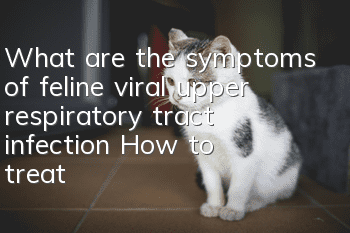What are the symptoms of feline viral upper respiratory tract infection? How to treat

Why does it cause viral upper respiratory tract infection in cats
There are usually two causes of viral upper respiratory tract infections in cats, viral rhinotracheitis and feline calicivirus (detailed introduction). Of course, the disease can also be co-infected with other diseases, making the cause more complicated. complex.
Viral rhinotracheitis is caused by feline herpesvirus type I (FHV-1), which is a double-stranded DNA virus and is extremely unstable outside the host body. FHV-1 can only survive in a humid environment for a few hours and is easily killed by common disinfectants. Contrary to FHV-1, FCV is a single-stranded RNA virus and has strong resistance outside the host body. Unlike FHV-1, some FCV strains can change their virulence and antigenicity. Despite widespread immunity to FHV-1 and FCV, these viruses continue to occur in domestic cats, especially in households with several cats and in animal shelters.
The infection route from virus-carrying cats to susceptible cats is generally direct contact, although the virus can only last for a short time in the environment. But cats living in high-density areas are highly susceptible to infectious secretions. Furthermore, kittens that recover from acute infection are very likely to develop into long-term FHV-1 or FCV carriers. This long-term state of infection can last from months to years and is the reason why the virus persists in the cat population. Especially in areas with a large population of kittens.
What are the symptoms of feline viral upper respiratory tract infection
Since the causes of viral upper respiratory tract infections in cats are different, the symptoms presented will also be different. Therefore, the manifestations of the disease are not single, and corresponding judgments must be made based on different situations.
Clinical symptoms of acute viral upper respiratory tract infection include sneezing with serous or mucopurulent nasal or ocular discharge, dehydration, anorexia, and conjunctival edema. Cats infected with FCV often experience oral itching. But it is less common in FHV-1 sick cats. Keratitis, dendritic ulcers, and severe conjunctival edema occur more frequently in FHV-1-infected cats than in FCV-infected cats.
It is difficult to distinguish between the two viruses based on clinical symptoms alone. In general, viral upper respiratory tract infections can be diagnosed based on clinical symptoms and medical history. As long as the treatment is selective, it does not matter whether different viral infections are distinguished. Cats with FCV may develop chronic, secondary bacterial rhinitis and sinusitis. Clinical symptoms can be relieved with antibiotics, but they usually reappear within 72 hours after stopping the drug. FCV is also associated with bacterial stomatitis and gingivitis. FHV-1 infected cats more commonly develop secondary symptoms, especially conjunctivitis, conjunctival edema, or keratitis, which may be unilateral or bilateral.
How to treat viral upper respiratory tract infection in cats
Feline viral upper respiratory tract infection is usually caused by two viruses, but it is difficult to distinguish which virus is caused by some clinical symptoms alone. However, as long as there is selective treatment, whether the cause can be distinguished does not have much impact. .
For kittens with viral upper respiratory tract infection, FHV-1 or FCV infection. Treatment focuses on providing good care, energy, fluids, and antibacterial therapy to deal with secondary bacterial infections. Dehydration can lead to increased secretions and difficulty breathing, and it is best to give fluids by mouth rather than parenterally. Feeding through a nasal tube can help provide energy to sick cats. There is currently no antiviral therapy for sick cats. The more popular antiherpes virus drug, acyclovir, has been found to be ineffective against FHV-1.
For cats with ulcerative keratitis caused by FHV-1, ophthalmic trifluridine (1% solution) can be used locally on the affected area every 4 hours until the clinical symptoms are relieved and discontinued for 1 week. . Topical anticongestants for humans can be used in cats for short-term relief therapy. Using these medicines for too long can cause congestion and rebound in the nasal cavity, making it difficult to breathe. When supportive care is provided, recovery from the infection is excellent. Without treatment, most infections self-limit within 10 to 14 days, but secondary bacterial infections can worsen the condition. Complicated pneumonia will harm the kitten, especially when Bordetella bronchiseptica is present, resulting in high mortality in affected kittens. Recovery depends on the development and clinical symptoms of the chronic carrier state, and FCV is associated with important upper respiratory tract and oral disease in long-term carrier states.
- What is the personality of the Korat cat?
- Why cats can’t drink water from plastic bowls because they are prone to black chins
- What to do if your Angora cat twitches while sleeping
- What should I do if my cat recognizes the baby? How to solve the problem of cats recognizing babies?
- What to do about kitten skin diseases
- What should I do if my cat doesn’t eat or drink when he arrives at his new home?
- Signs to determine whether a kitten is healthy
- Why do cats lick armpits with body odor?
- What should I do if my 2-month-old Siamese cat sneezes? Common diseases in cats!
- How long does it take for a kitten to forget its mother cat?



